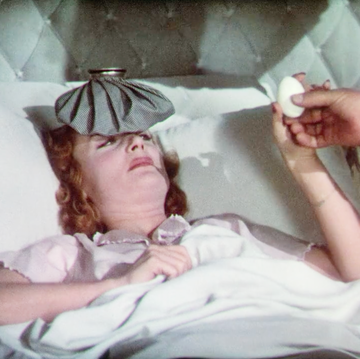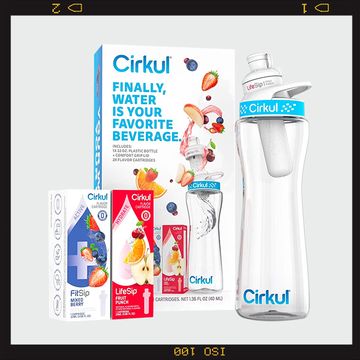Using a tampon is kind of a no-brainer, right? You pop one in, wait four to six hours, pull it out and repeat. Turns out, there are a lot of ways you could be using your tampon wrong. In fact, we’re willing to bet you’re guilty of at least one of the below mistakes.
Let’s start with the basics: You might be putting your tampon in wrong. How do you know if you inserted a tampon wrong? Well for starters, it’ll hurt. “Pain is never a normal thing,” explains Suzanne Gilberg-Lenz, MD, an OB/GYN at Women’s Care of Beverly Hills. If you have a tampon in correctly, you should barely be able to feel it throughout the day. Wondering why you keep putting your tampon in wrong? Hint: It probably has to do with not understanding your body and the right angle of insertion (but more on that later).
Already putting your tampons in right? Good for you. But there are still a lot of tampon rules left to learn. Like should you change tampons every time you pee? Yeah, that’s gonna be a yes from us (and one of the gynecologists we talked to). What about sleeping with a tampon in, is that cool? Let’s learn some helpful things, shall we?
You Use Two Tampons at Once (On Purpose)
Ladies with an extra heavy flow, you know what we’re talking about. But putting two tampons in at once for more absorption is never a good idea, says Dr. Gilberg-Lenz. “If you need two tampons, you should be using a super plus. And if you’re bleeding so heavily that that’s not enough, you need to go see your doctor.”
You Sleep With a Tampon In
According to Dr. Gilberg-Lenz, this is asking for trouble (aka an infection). You’re better off playing it safe by sleeping with an overnight pad, she says. Menstrual cups (if you don't have an IUD) are a great option for bedtime, too, because they can be left in for up to 12 hours.
You Don’t Know Where Your Tampon Is Going
Using a tampon is a great opportunity to learn about your anatomy, says Dr. Gilberg-Lenz. If you’re having trouble getting a tampon in, take some time to look at vag diagrams, like this one from the Cleveland Clinic, and use a hand mirror to find your way around and even stick your finger (clean, please) inside to get to know your body better.
You Leave Tampons Loose in Your Purse
Look, we’ve all thrown a handful of tampons in our bag on our way out the door. But don’t. That’s how they end up with torn wrappers. You’re much better off storing them in a pouch or little compartment in your purse, says Dr. Gilberg-Lenz.
You Don’t Keep Track of How Long You’ve Had Your Tampon in
You should change your tampon at least every eight hours to avoid developing toxic shock syndrome (TSS), a potentially deadly disease, according to Johns Hopkins Medicine. It can be easy to forget when exactly you put your last one in, so if you’re super forgetful, set an alarm for four to six hours from when you insert your tampon to make sure you change it. “If you’re like, ‘Did I put one in?’ ‘Did I not?’ you take your pointer finger or your middle finger and learn to feel if you’re not sure,” says Dr. Ross.
You only wash your hands after insertion.
Washing your hands before you get all up in there helps prevent contaminating your tampon on its way into your vagina, says Alyssa Dweck, MD, a gynecologist in Westchester, New York and coauthor of The Complete A to Z for Your V.
You don’t insert the tampon in far enough.
You’ll know because you’ll feel it: A too-shallow tampon will be super uncomfortable—you may even feel the cotton edge at the entrance to the vagina, Dr. Dweck says. (You shouldn’t sense anything when it’s properly positioned.)
You only use one absorbency level.
Although unlikely, tampons can cause toxic shock syndrome. Higher-absorbency tampons increase the risk of TSS, according to the Mayo Clinic, so it’s smart to use them only when you absolutely need to stop a super-heavy flow, Dr. Dweck says. The amount of blood can change from day to day throughout your period. Although supers might be a godsend on days one and two of your cycle, you’ll want to switch to a regular or light-absorbency product toward the end of the week.
It’s also worth noting that using a super-absorbent tampon when you have a lighter flow can dry out your vaginal tissue, says Lona Prasad, MD, a gynecologist at NewYork-Presbyterian Weill Cornell Medical Center in New York City. In fact, researchers found that vaginal dryness was closely linked to women who used super-absorbent tampons, according to a study published in the European Journal of Obstetrics & Gynecology and Reproductive Biology. That dryness can create tears or cracks in your vaginal walls, which increase your risk of infection, she says.
You only change your tampon once a day.
Even with a light flow, you should change that bad boy every four to eight hours, according to the American College of Obstetricians and Gynecologists. That’s because a moist tampon makes a warm, cozy home for bacteria. And the longer it’s in there, the greater your risk of TSS, Dr. Dweck says.
You use tampons to plug discharge.
Although it’s normal to experience discharge in the middle of your cycle, you shouldn’t need a tampon at that point. Stick it in, and you could disrupt the healthy vaginal bacteria that produce lactic acid, says Dr. Dweck. Reducing the vagina’s acidity can allow harmful bacteria to thrive and cause an infection, like bacterial vaginosis, according to the U.S. Department of Health and Human Services. If discharge still feels excessive, don’t just cork it; go to your doctor to get checked out.
You use a tampon the day after your period ends (just in case!).
Because pulling a dry piece of cotton out of an equally parched vagina can be more than a little uncomfortable, you should avoid this unnecessary precaution and pop in a pantyliner instead, Dr. Dweck says.
You don’t change your tampon after you pee…on it.
From a medical perspective, you don’t have to change your tampon every single time you use the bathroom, Dr. Dweck says. From a practical point of view: Who wants a soaking-wet string hanging out down there?
You don’t change your tampon after you poop.
If that string picks up any bacteria, it easily could infect the urethra, Dr. Dweck says. Another thing: Moving your bowels can sometimes dislodge a tampon, which could make leaving it in uncomfortable.
You forget to take it out.
Yes, this happens IRL. If you develop a horrible odor that can’t otherwise be explained, use a clean finger to feel around for a tampon. If for some reason you can’t pull it out, see a doctor, says Dr. Dweck.
You don’t change your tampon after swimming.
When you take a dip, so does your tampon. A string that’s laced with chlorine, saltwater, or lake water can cause skin irritation if you don’t change it quickly, Dr. Dweck says. The good news is that normal bacteria found in a body of water—or even a hot tub—likely won’t cause an infection, she says.
You use tampons with torn wrappers.
Tampon wrappers are designed to keep out dust, dirt, and makeup bits that live at the bottom of your bag or anywhere else you store them. When that wrapping rips, the cotton could pick up little debris that dot belong in your vagina, Dr. Dweck says.
You flush it.
Unless there’s a super hot plumber you’ve been dying to call, keep it out of the toilet.
You don't check the box's expiration date.
“They’re there for a reason. You don’t know what’s happening with the material it’s made of and if it’s gonna increase your risk of infections. Even if the packaging is intact and it’s been stored in the right place, you don’t really know what that means [for the] chemical makeup of the tampon,” explains Sherry A. Ross, MD, women’s health expert and author of She-ology: The Definitive Guide to Women’s Health. Period. If you can’t find the expiration date, if they’re more than 5 years old, chuck ’em).
You store them right between your shower and your toilet.
The wrapper and tampon itself will stay fresher longer if you keep it dry, Dr. Dweck says.
You use scented tampons.
Some women can react to the fragrance in scented tampons, according to the U.S. Department of Health and Human Services. In the worst-case scenario, you might experience irritation or an urge to itch. It’s why Dr. Dweck recommends unscented products—just in case.
Ashley Oerman is a contributing writer at Cosmopolitan, covering fitness, health, food, cocktails, and home. You can follow her on Instagram @AshleyOerman. She is pro-carbs.

Elizabeth Narins is a Brooklyn, NY-based writer and a former senior editor at Cosmopolitan.com, where she wrote about fitness, health, and more. Follow her at @ejnarins.













